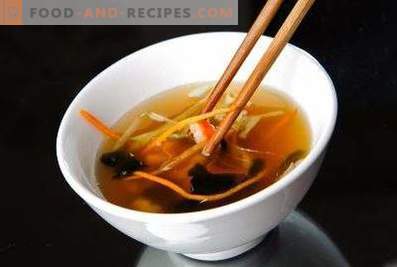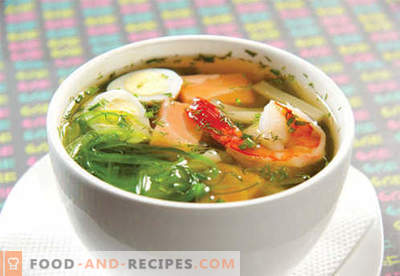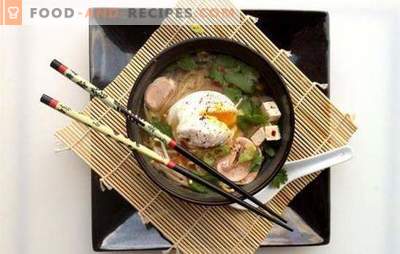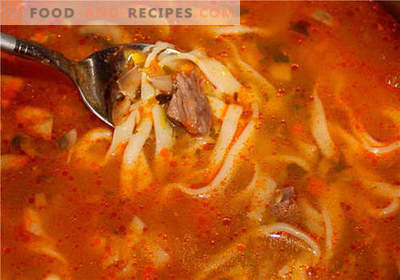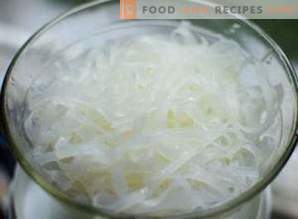
People interested in oriental culture are almost certainly familiar with the word nabemono. From Japanese, it can be translated as “things that can be put in a saucepan”. In the Land of the Rising Sun, this is the collective name of dishes that are prepared right at the table in a large, low saucepan, usually ceramic. The composition includes nabemono broth, meat, fish, seafood, seaweed, vegetables and other ingredients, as well as rice or noodles, the eating of which ends the meal. Those sitting at the table themselves choose which foods to eat and in what quantities, by placing them in their bowl with chopsticks. In a bowl, there may be a sauce or a raw egg, and products taken from the pan are dipped in before being sent to the mouth. For this reason, there is no one exact recipe for nabemono, but the most famous combinations of products have their own names. For example, sukiyaki is nabemono from beef with vegetables and noodles, esenabe from seafood with vegetables and tofu, sometimes with added chicken, tirenabe from fish with vegetables, isikarinabe from salmon, and yudofu from tofu.
Cooking Features
If you want to preserve the national flavor, serving on the table nabemono, but at the same time to please the guests, not shocking them with oriental exoticism, you should consider a few moments.
- If the guests are not accustomed to Japanese cuisine, you should not include products that are little known to them in the recipe, limiting yourself to algae, chicken or beef, fish and seafood, rice, noodles, tofu cheese, and vegetables. At the same time before the start of the meal will not interfere with notifying guests what exactly is in the pan.
- Traditionally nabemono served with chopsticks, and this is understandable. However, if a guest wants to use a cutlery that is more familiar to him, you should not refuse him.
- The pot for nabemono must be low enough, up to 10 cm, but its diameter depends on the number of guests: the more people sitting at the table, the greater must be the volume of the pan. It should be installed on the electric or gas stove in the center of the table and be accessible to everyone sitting at the table so that each guest can easily reach it and take what he liked. Catching food with chopsticks from a deep pan would be inconvenient.
- Nabemono is considered a winter dish, as it includes a lot of nourishing protein foods. A variety of this dish is used in their diet sumo wrestlers. In the daily diet, an excessive abundance of protein foods is undesirable, so be sure to add more vegetables to the dish.
- Given that nabemono is already prepared at the table, products for it should be cut as small as possible so that guests do not have to wait long before they can be tasted.
In Japan, the broth remaining after the main products are cooked in it is often used to make rice or noodles with which lunch is completed. If you do not cook rice or noodles in it, then it is undesirable to eat broth as food: it turns out to be too rich to be considered tasty and healthy.
Yosenabe (Esenabe)
Composition:
- shrimps (peeled) - 0, 2 kg;
- squid - 0, 2 kg;
- cod fillets - 0, 3 kg;
- tofu - 0, 2 kg;
- mushrooms - 100 g;
- Chinese cabbage - 0, 3 kg;
- sea kale - 0, 2 kg;
- leek - 0, 2 kg;
- udon noodles (made from wheat noodles) or plain egg noodles - 0, 2 kg;
- dashi (broth) from dried seaweed - 0.6 l;
- sake - 50 ml;
- soy sauce - 20 ml.
Method of preparation:
- Mix dashi, sake and soy sauce. Fill them with a saucepan of about 70%.
- Dice tofu.
- Squid cut into rings or strips resembling thick noodles.
- Cut slices of cod and mushrooms into an arbitrary shape.
- Chop Peking cabbage coarsely.
- Finely chop the onion.
- Dip the prepared ingredients, including sea kale, into the boiled broth, without mixing them together.
After 5-7 minutes you can start the meal. When all foods are eaten, cook noodles in the broth. If desired, add finely chopped chicken meat to the dish, and increase the amount of Chinese cabbage and sea kale.
Sukiyaki
Composition:
- beef - 0, 4 kg;
- tofu - 0, 4 kg;
- chicken egg (raw) - 4 pcs .;
- leek - 0, 3 kg;
- mushrooms - 100 g;
- gobo (burdock root) - 100 g;
- syungik (vegetable chrysanthemums) - 100 g;
- soy sauce - 0, 2 l;
- sugar - 10 g;
- dashi (seaweed broth) - 100 ml;
- beef or pork fat - 50 g.
Method of preparation:
- Prepare the sauce, pour half of it into a bottle, from which it will be convenient to pour it into the dish.
- Cut the beef into thin straws or very thin, almost transparent, slices, as for slicing.
- Cut tofu into cubes.
- Finely chop onions, mushrooms, gobos and chrysanthemums.
- In a saucepan or pan for nabemono heat the fat, fry the beef in it.
- Pour in the sauce that you did not pour into the bottle. Put tofu, mushrooms and vegetables in it.
- Before each guest, place a bowl with a raw egg.
After 5 minutes, you can take meat, dunk it in an egg and eat it, not forgetting to seize mushrooms and vegetables, soybean curd. It is important that you are confident in the safety of eggs. If there is no such guarantee, it is better to backtrack from tradition and serve sukiyaki without raw eggs.
Oden
Composition:
- fish balls - 4 pcs .;
- mushrooms - 0, 2 kg;
- tofu - 0, 2 kg;
- chicken egg - 4 pcs .;
- daikon - 0, 3 kg;
- dashi (algal broth) - 1, 5 l;
- soy sauce (lightly salted) - 100 ml.
Method of preparation:
- Dykon with a peeler cut into thin strips.
- Mix the broth and soy sauce, boil the daikon in it for 40 minutes and leave to infuse for several hours.
- Cut tofu into 2 cm cubes.
- Cook hard boiled eggs, cut each into 4 pieces.
- Cut the mushrooms.
- Heat the broth with daikon. Dip fish balls and mushrooms in it, add tofu and eggs in 10 minutes. After 5 minutes you can sit down at the table.
Oden is served with spicy sauce. You can use wasabi or mustard.
Nabemono is a nutritious dish and ritual at the same time. After all, they eat it from a common pan, in which it is cooked right during lunch. There is no single recipe for nabemono, as there can be a lot of combinations of products in the pan. So there is always room for fantasy.
